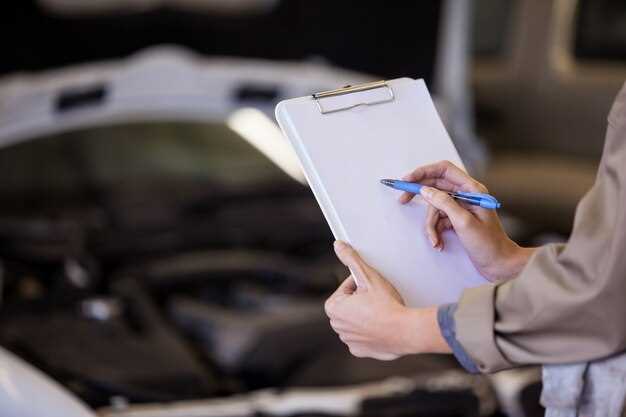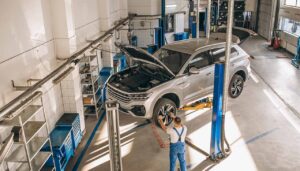
Failing a car emissions test can be a frustrating experience for any vehicle owner. It often signifies underlying issues with your car’s engine or exhaust system that need immediate attention. Understanding the next steps can help you navigate this situation effectively and ensure that your vehicle meets the required environmental standards.
First and foremost, it is crucial to review the specific reasons for the failure, which will typically be noted on the emissions test report. This document outlines the areas where your vehicle did not comply with established regulations. Familiarizing yourself with this information is essential as it will guide your subsequent actions and repairs.
Once you have assessed the failure reasons, your next step should be to schedule a diagnostic inspection with a qualified mechanic. This expert can provide a thorough evaluation of your car and identify the precise issues that led to the emissions test failure. It is important to address these concerns promptly, as ignoring them can lead to more significant and costly repairs down the line.
After the necessary repairs are completed, you will need to arrange for a retest to ensure that your vehicle now complies with emissions standards. The goal is to restore your car’s performance and environmental compliance, helping you contribute positively to air quality while staying within legal requirements.
Understand the Reason for Your Test Failure
When you receive the results of your car emissions test, it is crucial to identify the underlying reasons for the failure. Understanding these reasons is the first step toward addressing the issues and improving your vehicle’s performance.
Examine the Test Results – Review the detailed report provided by the testing facility. Look for specific measurements that indicate which pollutants were above the permissible limits. Common culprits include hydrocarbons, carbon monoxide, and nitrogen oxides.
Check for Common Issues – Several typical problems may cause emissions failures. Ensure that your catalytic converter is functioning properly, as it plays a key role in reducing harmful emissions. Additionally, inspect your vehicle’s oxygen sensors, as faulty sensors may lead to incorrect fuel mixture and increased emissions.
Look for Warning Lights – If your dashboard has illuminated warning lights, this could be indicative of serious engine issues. Diagnostic trouble codes (DTCs) generated by your vehicle’s onboard computer can provide valuable insights into what might be wrong.
Consider Maintenance History – Reflect on your car’s maintenance history. Inadequate maintenance, such as skipped oil changes or neglected air filters, can lead to degraded engine performance and higher emissions. Regular inspections and prompt repairs are crucial to maintaining a healthy vehicle.
Consult a Professional – If you are unable to diagnose the issue yourself, consider taking your vehicle to a trusted mechanic. Professionals have the tools and expertise to run diagnostics and pinpoint the cause of your emissions failure effectively.
Understanding the reason behind your emissions test failure is essential for making informed decisions about necessary repairs and adjustments. By taking the time to investigate and address the issues, you can ensure that your vehicle meets environmental standards and operates efficiently.
Research Repair Options for Your Vehicle
After failing your car emissions test, it is essential to explore various repair options to address the underlying issues. Begin by identifying the specific reasons your vehicle did not pass the test, which can typically be found on the emissions test report.
1. Consult a Certified Mechanic: Engaging a certified mechanic is crucial. Look for a professional who specializes in emissions systems to ensure accurate diagnosis and repair. They can provide detailed insights into necessary fixes.
2. Get Multiple Quotes: Don’t settle for the first estimate. Reach out to several repair shops to compare quotes and services. This will help you find the most cost-effective repair solution without compromising quality.
3. Research Common Emission Issues: Familiarize yourself with common problems that lead to emissions failures, such as faulty oxygen sensors, catalytic converters, or exhaust leaks. Understanding these issues can help you communicate effectively with your mechanic.
4. Review Online Resources: Explore online platforms and forums related to automotive repairs. Websites like Consumer Reports or RepairPal can provide valuable feedback on local repair shops and advice on repairs.
5. Check for Warranty Coverage: If your vehicle is still under warranty, review the terms to see if emissions-related repairs are covered. Using authorized dealerships for service can also ensure quality repairs and keep your warranty intact.
6. Consider DIY Repairs: If you are mechanically inclined, some minor repairs may be manageable on your own. However, ensure you have the proper tools and knowledge, as incorrect repairs may lead to further issues.
By systematically researching your repair options, you can make informed decisions to restore your vehicle’s emissions system and achieve compliance on subsequent tests.
Calculate the Costs of Necessary Repairs

After failing your car emissions test, the next critical step is to determine the costs associated with the necessary repairs. This process involves assessing the vehicle’s issues accurately to budget effectively for the fixes.
1. Identify the Problem Areas
Begin by reviewing the emissions test report to pinpoint the specific components that failed. Common issues include malfunctioning oxygen sensors, catalytic converters, or exhaust leaks. Understanding these failures will help you get accurate repair estimates.
2. Research Repair Costs
Once you have identified the problem areas, conduct research on the average costs of repairs for those components. You can use online resources, such as automotive forums, repair websites, or quote tools, to gather data. Additionally, contacting local mechanics for estimates can provide direct information on labor and parts costs.
3. Factor in Labor and Parts
When calculating potential expenses, include both the cost of replacement parts and labor fees. Labor rates can vary significantly based on location, mechanic experience, and the complexity of the repair. Be sure to obtain a detailed breakdown of these costs from any prospective repair shop.
4. Consider Additional Charges
In addition to parts and labor, consider other expenses such as tax, shop supply fees, or diagnostic fees that may apply. It’s important to account for these to avoid unexpected costs that could impact your budget.
5. Evaluate Your Budget
Assess your financial situation to ensure you can afford the required repairs. If the total cost exceeds your budget, prioritize essential repairs that will help your vehicle pass the emissions test. Consider exploring financing options or assistance programs if necessary.
6. Plan for Future Maintenance
Once repairs are done, think about how regular maintenance can prevent future failures. Schedule routine check-ups, oil changes, and emissions tests to keep your vehicle in compliance and to reduce long-term repair costs.
By calculating the costs of necessary repairs accurately, you can make informed decisions that ensure your vehicle meets emissions standards while staying within your budget.
Explore Local Emissions Repair Assistance Programs
If you have failed your car emissions test, it is important to know that you are not alone and there are programs available to assist you with repairs. Many states offer emissions repair assistance programs designed to help eligible vehicle owners cover the costs of necessary repairs. Here are key aspects to explore:
- Research Local Programs: Start by checking your state’s Department of Environmental Protection or similar agency website. These sites often list available programs, application processes, and eligibility criteria.
- Financial Assistance: Some programs provide financial aid for repairs, including grants or low-interest loans. Understand the funding limits and how these funds can be applied to your repair costs.
- Eligibility Requirements: Eligibility may depend on factors such as income, vehicle type, and the age of the vehicle. Carefully review these criteria to determine if you qualify for assistance.
- Participating Repair Shops: Identify which local repair shops are authorized to provide services under the assistance program. It’s crucial to have your vehicle repaired by a licensed technician affiliated with the program.
- Application Process: Follow the outlined application steps meticulously. Prepare necessary documentation, including proof of income, vehicle information, and results of your emissions test.
- Seek Community-Based Organizations: Local non-profits and community groups may also provide assistance or guidance for emissions repairs. Look for workshops or informational sessions that can help you navigate the available options.
Participating in an emissions repair assistance program can significantly relieve the financial burden of necessary repairs. Make sure to take swift action to explore these options after failing your emissions test.
Re-test Your Vehicle After Completing Repairs
Once you have addressed the issues that caused your vehicle to fail the emissions test, it is crucial to have your vehicle retested. This step ensures that any repairs made effectively reduced emissions to meet regulatory standards.
Before scheduling the re-test, give your vehicle sufficient time to reset its onboard diagnostics (OBD) system. Depending on the repairs, this may require driving your vehicle for a specific distance or duration. Consult your vehicle’s manual or a professional mechanic for guidance on how to properly reset the system.
When you return for the emissions re-test, choose an official testing center. Ensure they use updated equipment and adhere to local regulations. Bringing documentation of the repairs can also be beneficial as it provides context for the technician.
Be prepared for additional repairs if your vehicle still fails emissions. The re-test results will offer insights on persistent issues, helping you identify further necessary actions to ensure compliance.
Passing the re-test is critical, not only for regulatory reasons but also for the overall health of your vehicle, improved fuel efficiency, and reduced environmental impact. Make sure to maintain your vehicle regularly to avoid future emissions problems.
Maintain Vehicle Emission Standards for Future Tests
To ensure your vehicle continues to meet emission standards and passes future tests, regular maintenance and conscientious driving practices are essential. Here are key strategies to maintain optimal vehicle performance and minimize harmful emissions:
| Action | Description |
|---|---|
| Regular Engine Checkups | Schedule comprehensive inspections to identify and resolve issues that can lead to increased emissions. Focus on fuel systems, ignition systems, and exhaust components. |
| Change Oil Regularly | Use the manufacturer-recommended oil type and change it at intervals prescribed in the owner’s manual. Clean, fresh oil improves engine efficiency. |
| Monitor Tire Pressure | Keep tires inflated to the optimal pressure. Under-inflated tires can decrease fuel efficiency and increase emissions due to additional strain on the engine. |
| Replace Air Filters | Inspect and replace air filters as needed. A clean air filter allows for improved airflow to the engine, enhancing fuel efficiency and lowering emissions. |
| Use Quality Fuel | Opt for high-quality fuel that meets or exceeds the specifications recommended by your vehicle’s manufacturer. Better fuel reduces deposits and helps the engine run cleaner. |
| Check the Exhaust System | Regularly inspect the exhaust system for leaks, blockages, or damage. A well-functioning exhaust system reduces harmful emissions and enhances engine performance. |
| Keep the Check Engine Light Addressed | If the check engine light appears, diagnose and resolve the underlying issues promptly. Ignoring this warning can lead to significant emissions violations. |
| Limit Short Trips | Avoid frequent short trips, as engines require time to reach optimal operating temperatures. Combining errands can reduce cold starts, which elevate emissions. |
By adhering to these maintenance practices and making conscientious choices, you can significantly enhance your vehicle’s emissions performance. Staying proactive will not only help you pass future tests but also contribute to a cleaner environment.














